Perfect One Day in Yellowstone Itinerary for First-Timers

Looking to make the most of your day trip to Yellowstone National Park?
This is one of the most popular National Parks in the country and one of my absolute favorites! So, I’m going to walk you through a jam-packed one day in Yellowstone National Park itinerary, inspired by my own adventure through this geological Disneyland during my 5 month Rockies road trip.
To be honest, one day isn’t nearly enough to fully appreciate the vast and diverse beauty of Yellowstone. After all, it’s a sprawling wilderness playground that spans over two million acres across Wyoming, Montana, and Idaho.
It’s not just a drive-through kind of park. I ran around for 5 days in the park and even picked up a hitchhiker to hang out with. All the while, I was juggling remote work with limited cell service, so you should be able to amp up the pace a bit more.
That being said, if you only have time for a Yellowstone day trip, this itinerary will help you see some of the most iconic and must-see sights. At the end, I’ll share a few must-visit spots and wrap up with a handy mini-guide filled with practical tips and information.
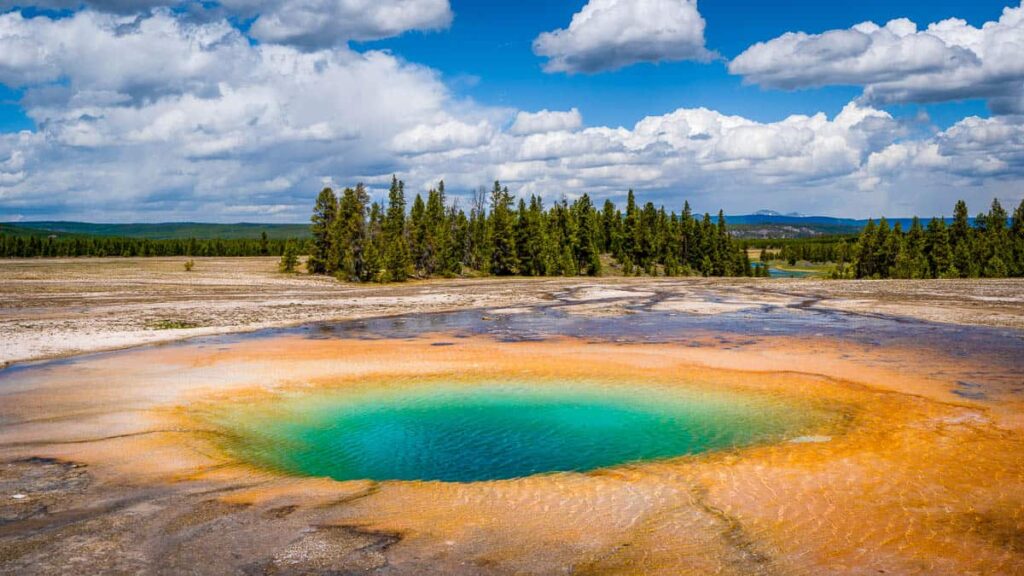
Sample One Day in Yellowstone Itinerary
Having a single day is a truly whirlwind tour of Yellowstone National Park at a speed I wouldn’t necessarily recommend. I highly suggest dedicating at least one day to the lower loop and another to the upper loop, but this will cover all the major points in both loops.
Be prepared for a lot of driving and needing to miss some stops. Also note that Norris Geyser and the Grand Canyon of the Yellowstone are shared by both loops.
Want someone else to handle the logistics? Here are my top tour picks from the different entrances.
🦬 From Jackson: Reserve this top-rated tour for the entire Lower Loop and Grand Teton intro
🦬 From West Yellowstone: Sign up for this Lower Loop excursion to all the top destinations
🦬 From Bozeman: Book this wildlife tour to focus more on the safari aspect
Can’t Miss Destinations:
- Grand Prismatic Springs
- Old Faithful
- Grand Canyon of Yellowstone
- Wildlife Viewing at Hayden or Lamar Valley
Lower Loop:
- West Thumb Geyser Basin: Start with this boardwalk trail along Yellowstone Lake only if you’re coming in from the South Entrance. Otherwise, it’s a bit much of a detour.
- Old Faithful: Head north for this iconic geyser that erupts every 60-110 minutes. Walk along the path to see other geysers and springs like Castle Geyser and Morning Glory Pool as well.
- Midway Geyser Basin: Walk the boardwalk loop around Grand Prismatic Spring, one of the parks most famous and photographed spots.
- Optional if open: Take the Fairy Falls trailhead to the overlook for Grand Prismatic Spring. It’s only an extra half mile each way to the popular hike, and you can tack on a waterfall.
- Fountain Paint Pot: Mud pots, hot springs, and geysers, oh my! This place is seriously bubbling with activity.
- Madison to Norris: Some overlooks like Gibbon Falls on this road in addition to pretty scenery.
- Norris Geyser Basin: The hottest and oldest thermal area in the park, where you can witness the incredible Steamboat Geyser, the world’s tallest active geyser.
- Grand Canyon of Yellowstone: The views from Artist Point are just… wow.
- Hayden Valley: An animal lover’s paradise. Keep an eye out for bison, elk, and, if you’re lucky, a bear or two (from a safe distance, of course).
Upper Loop:
- Tower Fall: A must-see 132-foot waterfall that plummets into the Yellowstone River, easily accessible from the Tower-Roosevelt area.
- Mammoth Hot Springs: A wonderland of steaming terraces formed by centuries of mineral deposits
- Lamar Valley: Often referred to as America’s Serengeti for its large and easy-to-spot populations of bison, wolves, and bears. End your day with a spectacular sunset and some prime wildlife watching.
Recommended Places to Stay in Yellowstone
- 📍Cody, WY: The Cody Hotel
- 📍Gardiner, MT: Yellowstone Gateway Inn
- 📍Bozeman, MT: The LARK
- 📍West Yellowstone, MT: Explorer Cabins at Yellowstone
- 📍Jackson, WY: Snow King Resort
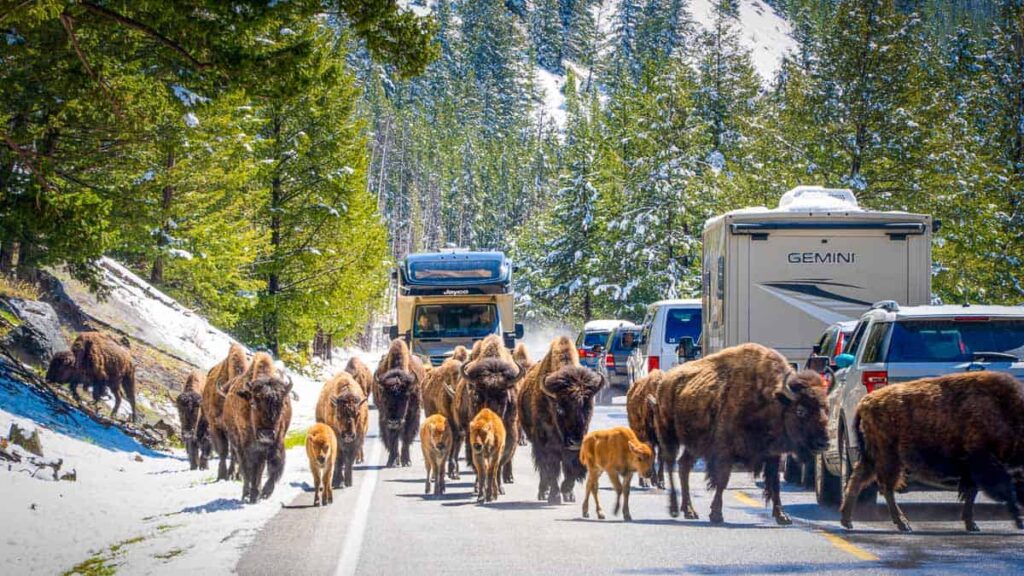
Quick Facts about Visiting Yellowstone
Yellowstone National Park, sprawling over a mind-boggling 2.2 million acres, is larger than the states of Rhode Island and Delaware combined, and it’s brimming with over 10,000 hydrothermal features.
With the world’s largest concentration of geysers, including the famous Old Faithful, the Grand Canyon of Yellowstone, and the chance to spot bears, wolves, and herds of bison, it’s no wonder this was America’s and the world’s very first National Park.
| Quick Facts | Details |
|---|---|
| Entrance Fees | $35 per vehicle, $30 per motorcycle, $20 per individual on foot/bike, or 80$ for the American the Beautiful Annnual Pass |
| Operating Hours | Most facilities operate from late-April to early November. Most of the roads shut down on November 1, except for the route between the northern entrances. |
| Visitor Centers | Albright Visitor Center, Canyon Visitor Education Center, Fishing Bridge Visitor Center, Grant Visitor Center, Madison Information Station, Norris Geyser Basin Museum, Old Faithful Visitor Education Center |
| Park Entrances | 5 Entrances (North, Northeast, East, South, West) |
| Main Activities | Hiking, wildlife viewing, camping, fishing, boating, snowshoeing, cross-country skiing. I use Viator to find specific guided excursions. |
| Number of Campgrounds and Hotels | 12 campgrounds, 9 hotels Recommended hotels in nearby towns: 📍Cody, WY: The Cody Hotel 📍Gardiner, MT: Yellowstone Gateway Inn 📍Bozeman, MT: The LARK 📍West Yellowstone, MT: Explorer Cabins at Yellowstone 📍Jackson, WY: Snow King Resort |
| Best Time to Visit | Late April to early June or September for fewer crowds, mild weather, and active wildlife |
| Nearest Cities & Distances | Bozeman, Cody, Jackson Hole Use DiscoverCars to find rental car deals, or rent and RV or campervan through Outdoorsy. |
| Nearest Airports & Distances | Yellowstone Airport (2 miles), Bozeman Yellowstone International Airport (88 miles), Jackson Hole Airport (49 miles) Use Expedia to find the best flight prices. |
Choosing Your Yellowstone Entrance
The park has five main entrances, and with such great distances where you come in from really determines what you’re able to see.
The North Entrance at Gardiner, Montana, is the only entrance open year-round and brings you directly to the Mammoth Hot Springs. The Northeast Entrance near Cooke City is most convenient if you’re coming from the Beartooth Highway. On the other hand, the East Entrance from Cody, Wyoming, runs through the scenic Sylvan Pass and positions you well to explore Yellowstone Lake early in your visit.
If you’re coming from Jackson, Wyoming, the South Entrance leads you through the Grand Teton National Park. Lastly, the West Entrance in West Yellowstone, Montana, is one of the busiest, providing direct access to the geyser basins, including Old Faithful. This entrance is ideal for visitors aiming to experience the geothermal wonders from the get-go.
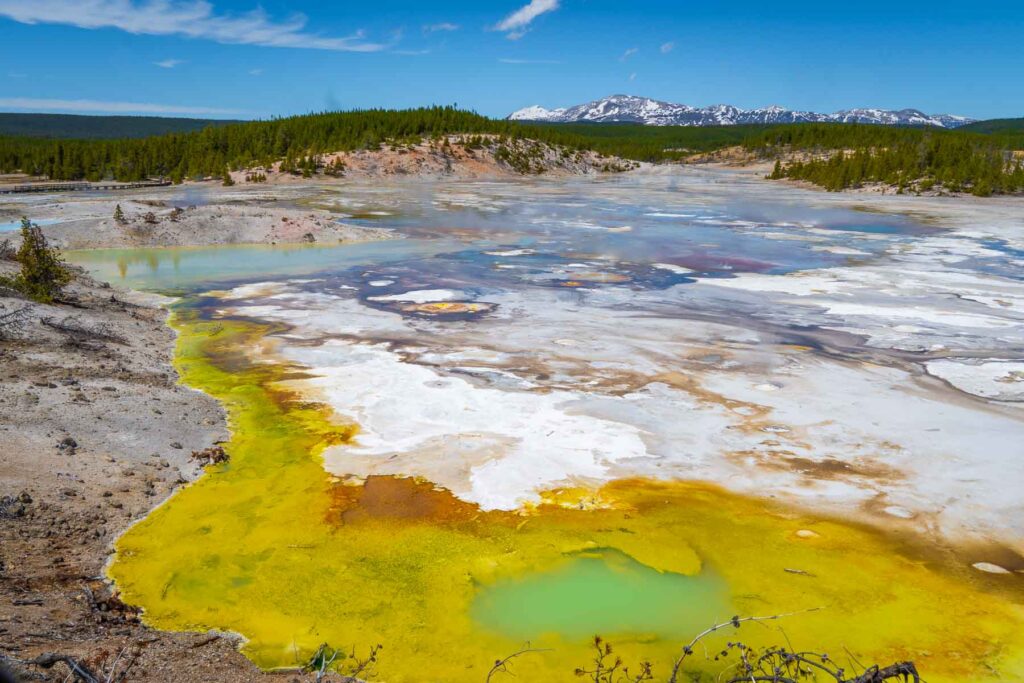
Essential Tips Before You Go!
- Permits and Reservations: Certain activities may require permits or reservations. For backcountry camping, you must obtain a permit and make campsite or hotel reservations well in advance, especially in peak season.
- Shuttle Use: There’s no official park shuttle, but various tour operators provide transportation services. Opting for one of these can save you the hassle of driving and parking.
- Road Closures: Many roads in the park are closed from early November to late April due to snow. Check the park’s website for up-to-date road conditions.
- Bear Spray: Even though I never opened the box, I carry bear spray and know how to use it.
- Stay on the Path: The park’s hydrothermal areas can be dangerous. Always stick to the boardwalks and trails.
- Wildlife Safety: As cute as they are, bison are dangerous. There are people who get gored every year. Don’t get too close.
- Cell Service: Don’t count on having cell service throughout the park. Consider downloading offline maps like maps.me ahead of time.
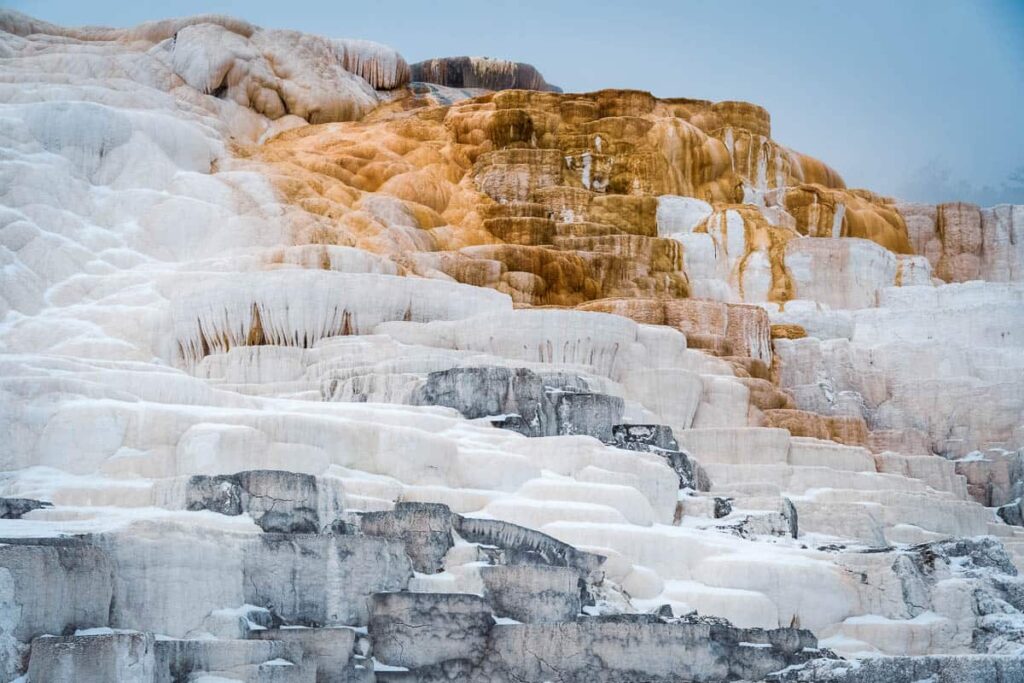
What to Do in Yellowstone in One Day on the Grand Loop Road
If you only have one day to spend in Yellowstone, the bottom half of the Grand Loop Road is your best bet for experiencing some of the park’s highlights. This 142-mile loop takes you through the major areas of Yellowstone and can be completed in about eight hours without stops.
Most people come in from the West Entrance, so we’ll start there and go counter-clockwise to Old Faithful, then u-turn. However, you can start at any entrance, depending on where you’re staying. Keep in mind that summer is peak season, so the earlier you start, the better.
West Thumb Geyser Basin
If I were coming in from the South Entrance, I’d make the first stop along the Grand Loop Road to West Thumb Geyser Basin. However, from the West Entrance, this is something I would skip as there are plenty of other Geyser Basin’s to check out.
This spot is on the shoreline, with geysers and hot springs spilling into the vast Yellowstone Lake. West Thumb may not have the same fame as other basin areas, and it’s smaller than some of the other geyser areas, but there are still colorful hot springs with names like Abyss Pool and Black Pool, and it’s a cool combination of lake views and thermal features.
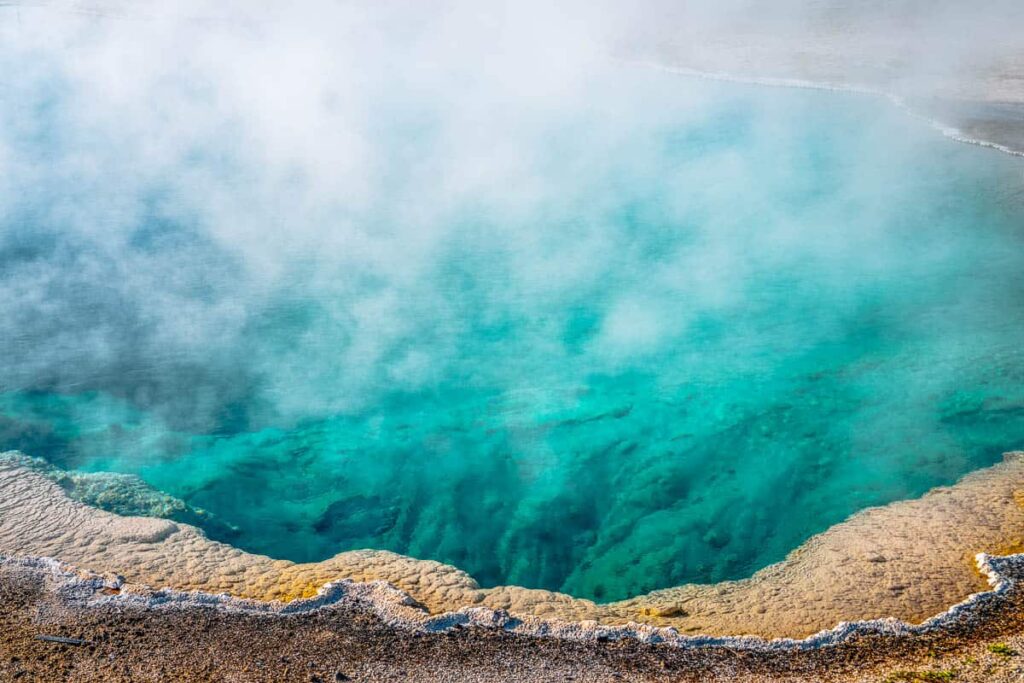
Old Faithful
Next up is a must-see, the Old Faithful Geyser. The drive from West Thumb to Old Faithful takes about 30 minutes, and you can stop at Kepler Cascades on the way. Once at Old Faithful, I recommend spending some time walking around the Upper Geyser Basin Boardwalk, which loops through the hottest and most active section of geysers in the park.
Try to catch an eruption early in the morning or late in the afternoon when the crowds have thinned. The geyser erupts every 90 minutes or so, give or take 10 minutes, which means you have plenty of opportunities to witness its grandeur. Find the geyser eruption times here.
Otherwise, the nearby Old Faithful Visitor Education Center has exhibits, and the historic Old Faithful Inn is a national historic landmark to grab a bite, a hot drink, or have an expensive rest.

Midway Geyser Basin
Continuing along the Grand Loop Road, the next stop is the Midway Geyser Basin. This area features two striking features: Grand Prismatic Spring and Excelsior Geyser Crater. The large boardwalk of this geyser basin gets you an up-close view of its main attractions.
Grand Prismatic Spring is Yellowstone’s largest hot spring and the third-largest in the world! The colors are mind-blowing, and the size is striking, with rings of vibrant color fading from a fiery orange to a deep blue center. Seeing pictures of this is why I had Yellowstone on my bucket list.
Excelsior Geyser Crater is another impressive sight with its blue waters and constant steam rising from its surface. Once a mighty geyser that could erupt to more than 300 feet, it’s now a boiling hot spring.
The boardwalk around Midway Geyser Basin is a manageable 0.8 mile (1.3 km) loop. Watch your stuff, and even if your hat gets blown off your head, don’t get off the path. The earth is thin, and the water beneath is nearly boiling!

Grand Prismatic Spring Overlook
- Length/Duration: 0.6 miles round trip/30 minutes
- Difficulty: Easy
- Trailhead: Fairy Falls Trailhead
- Closures: Open in Mid-May; parking is limited
If you’re up for it, and the parking lot isn’t full, make the hike to the Grand Prismatic Spring Overlook.
As cool as the view from the boardwalk is, the spring is way too big to be able to see the full size of it. This overlook gives you a different perspective of the hot spring, so you can see an even more epic view from above.
It’s accessed via the Fairy Falls Trail, and you can expect to hike about 0.6 miles (0.9 km) one way to reach the overlook. The path to the overlook is relatively easy-going, with a gentle uphill trek.
The trail continues on to the picturesque Fairy Falls, so if you’re up for a longer walk of 5 miles (8 km) round trip, keep going to round out your adventure with a waterfall finale. You probably won’t have time for this on a Yellowstone day trip.
Fountain Paint Pot
As you keep driving on the Grand Loop Road, you’ll come across the Fountain Paint Pot, another cool spot in the park. However, it’s not too different from the Midway Geyser Basin and maybe not as impressive. So, if you’re short on time, I would say you can skip it.
Named after its mud pots that resemble pots of bubbling paint, this spot features a half-mile (0.8 km) loop that takes you past some of the most active geothermal features in the park. You have fumaroles, which are basically steam vents, hissing as they release volcanic gases. Then, there are the hot springs, brilliantly clear and sparkling but scalding hot.
But, it’s the mud pots you’re here for. They’re basically acidic hot springs with a limited water supply, which gives them that thick, goopy consistency that pops and plops.
The mud pots actually change with the weather and seasons, ranging from thin and watery in the spring to thick and gooey in the drier months.
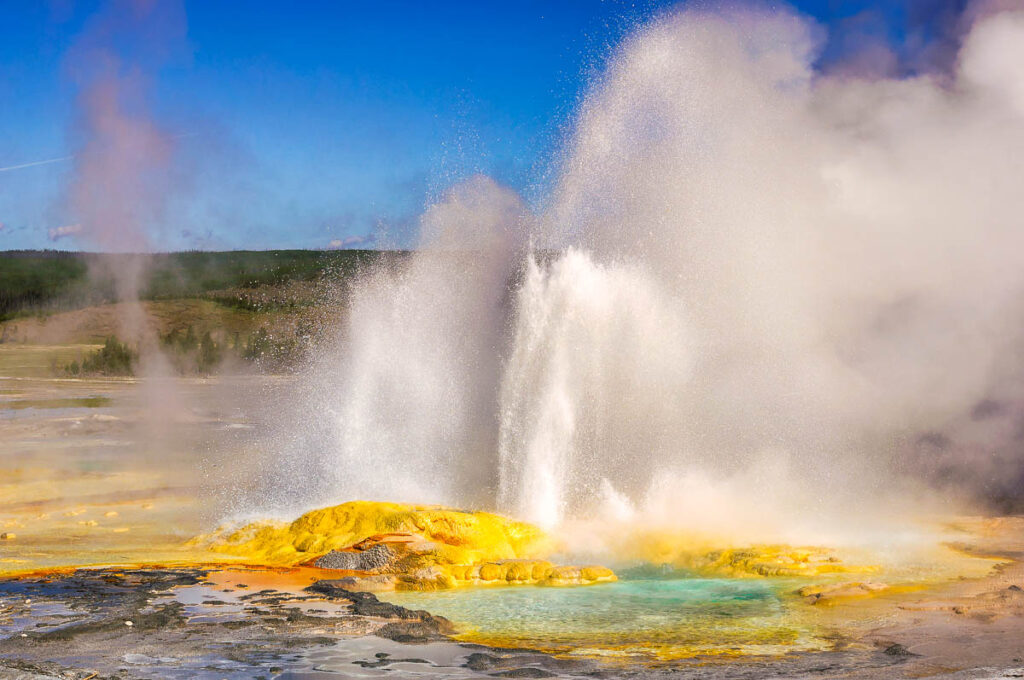
Norris Geyser Basin (Connected with Upper Loop)
Norris holds the title of the park’s hottest and most dynamic geyser basin. The boardwalks here take you close to some bizarre features.
There are two main trails here: the Porcelain Basin and the Back Basin. Both have boardwalks that take you through the basin’s hot springs, fumaroles, and geysers. The colors here are stunning, with hues of orange, red, yellow, and green all around as a result of the high temperatures and thermophilic bacteria thriving in the hot waters.
The Porcelain Basin is a shorter loop at 0.5 miles (0.8 km), so it’s perfect for those short on time or with limited mobility. Here, Porkchop Geyser erupts every few minutes.
The Back Basin has a longer loop of 1.5 miles (2.4 km). It’s more forested compared to the Porcelain Basin’s openness. This part of the Basin is home to the world’s tallest currently active geyser, the impressive Steamboat Geyser. It doesn’t erupt on a predictable schedule, but when it does, water rockets skyward up to 300 feet!
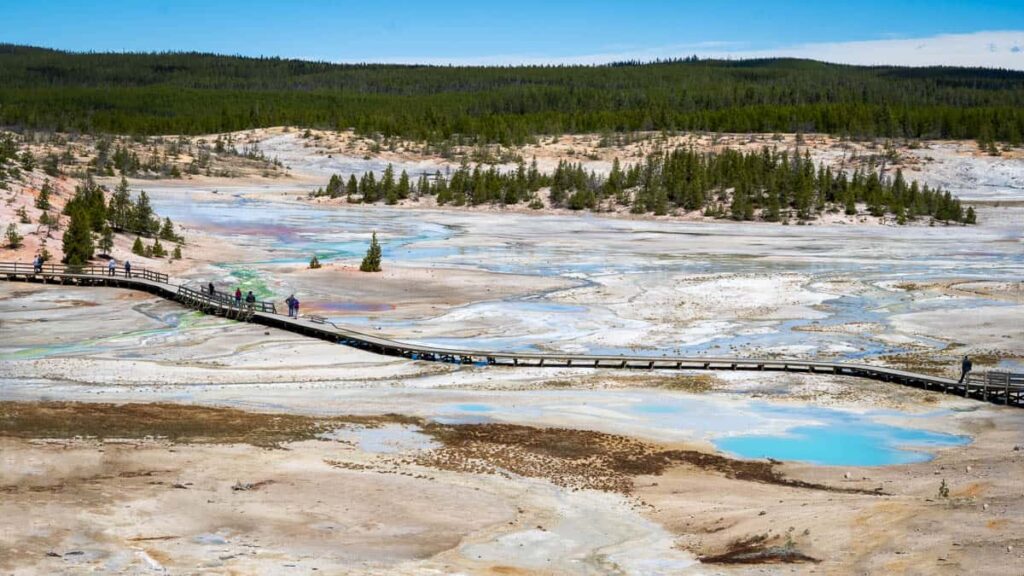
Grand Canyon of the Yellowstone (Connected with Upper Loop)
Honestly, if you stop here, you’re already going to have a pretty full day. If you have a second day, I would save the rest of the Upper Loop for the next day, so you also have more time to catch sight of wildlife.
As you make your way towards Canyon Village along the east side of the Grand Loop Road, the Grand Canyon of the Yellowstone is just wow. I never knew that Yellowstone had its very own Grand Canyon. This canyon is estimated to be up to 20 miles long, over 1,000 feet deep, and between 1,500 and 4,000 feet wide in places, with the Yellowstone River coursing through its base.
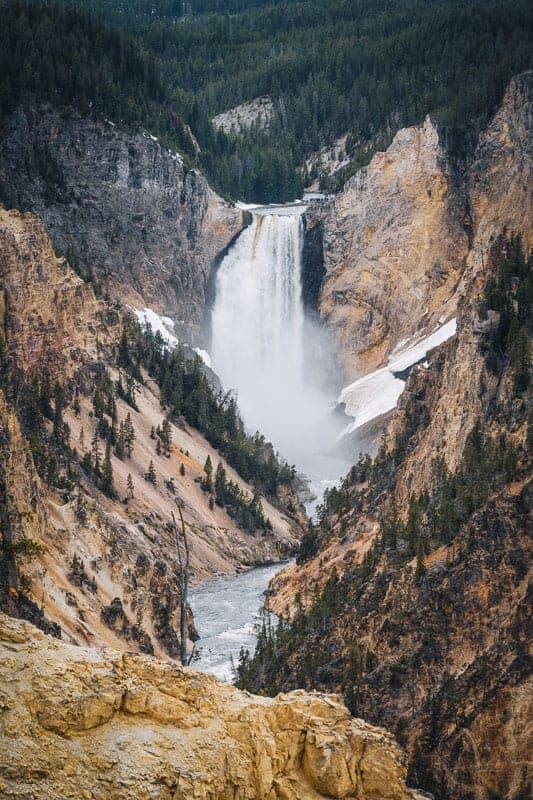
Artist Point
One of the best viewpoints is Artist Point, where there are panoramic views of the Lower Falls and the multi-hued rock walls of the canyon.
Lower Falls
The Lower Falls is the tallest waterfall in Yellowstone, plunging a mesmerizing 308 feet. For context, that’s nearly twice as high as Niagara Falls! The sound of the water crashing down into the canyon can be thunderous, especially in the spring when the snowmelt swells the river.
There are multiple spots to take in the falls, but the trail to the brink of the Lower Falls is a must-do for that up-close and personal experience that you can feel in your chest.
Hiking Trails
One of the best ways to experience the Grand Canyon of the Yellowstone is by taking a hike down to the base of Lower Falls on Uncle Tom’s Trail. Otherwise, the North Rim Trail gives you a series of breathtaking views, while the South Rim Trail connects to Uncle Tom’s Trail. For a more strenuous hike, the Seven-Mile Hole Trail will lead you into the depths of the canyon itself.
Hayden Valley (Optional)
Due to my particular route and the fact that I had more time, I picked to go wildlife watching in Lamar Valley, but Hayden Valley is another one of the best places in Yellowstone to spot wildlife. This vast valley stretches over 12 miles, with the Yellowstone River meandering through it and offering views of bison grazing along its banks.
There are also several hiking trails in Hayden Valley that take you closer to the river. Bison herds roaming free are almost a guaranteed sight, and you might even spot elk, coyotes, or a grizzly bear.
Early morning or late afternoon times are prime for wildlife action with fewer crowds. Also, every time you see other cars stopped on the road, that’s a clue that there’s something to look for.

what to see in Yellowstone in one day on the Upper Loop
If you’re coming from the northern loops, you’ll have a lot more ability to run into the wildlife. Grand Canyon of the Yellowstone and Norris Geyser are both shared by the Upper Loop as well, so tack those on.
Tower Fall
But if you do have more time, continue your journey at Tower Fall. Located near the northeastern entrance, this natural wonder is a dramatic 132-foot plunge of Tower Creek, framed by eroded volcanic pinnacles that give the area its name.
As you approach Tower Fall, a well-maintained path leads you to an overlook where you can hear the thunderous sound of water before even seeing the fall. If you’re feeling adventurous, you can take the trail leading down to the base of the fall. The trail is only 0.6 miles round trip and takes you through a beautiful pine forest.

Mammoth Hot Springs
This is where things get difficult; depending on which exit you are leaving from, you’ll have to pick between Mammoth Hot Springs and Lamar Valley. If you’re not going the Lamar Valley route and if you haven’t seen wildlife yet, try Hayden Valley.
Moving towards the northern exit, Mammoth Hot Springs are terraced hot springs that have been formed by the flow of mineral-rich water over thousands of years. You’ll see terraces made of travertine (that’s basically a fancy word for a type of limestone) that’s been deposited by mineral-rich hot waters spewing from the earth.
The boardwalks take you through Upper Terrace and Lower Terrace. You can also take a drive through the Upper Terrace Drive for more scenic views.
Because this area is super dynamic, some springs might be dry while others are active, and it can change from year to year.
And while you’re there, don’t miss the historic buildings of Fort Yellowstone. This area was once a military outpost and now serves as park headquarters.

Lamar Valley
Going in the opposite direction towards the northeastern exit, Lamar Valley is known as the “American Serengeti.” This vast, open valley has some of the most reliable wildlife viewing opportunities. I saw herds and herds of buffalo here.
To increase your chances of spotting wildlife in Lamar Valley, head out early morning or late afternoon when the animals are most active. It’s also a good idea to bring binoculars and a telephoto lens for your camera.
Aside from the more common mammals, try to spot the predators too. Wolves, re-introduced to Yellowstone in the mid-1990s, have a stronghold here. If you’re incredibly lucky and patient, you might witness a pack in action or the grizzly and black bears inhabit this region.

Where to Stay in Yellowstone
For the coolest in-the-park hotel experience, the historic Old Faithful Inn is steps away from iconic geysers and hiking trails. But most of us can’t afford to stay here, or even if you do, it’s sold out so far ahead.
West Yellowstone and Gardiner are often touted as the best towns to base yourself in due to their proximity to the park’s entrances. Otherwise, Jackson is a popular outdoors town if you plan on combining a trip to Grand Teton.
If you prefer to be inside the park to reduce driving time, you can stay in Madison, Norris, or Canyon Village, and the Old Faithful Inn is the only in-park hotel open year-round, but it’s not cheap.
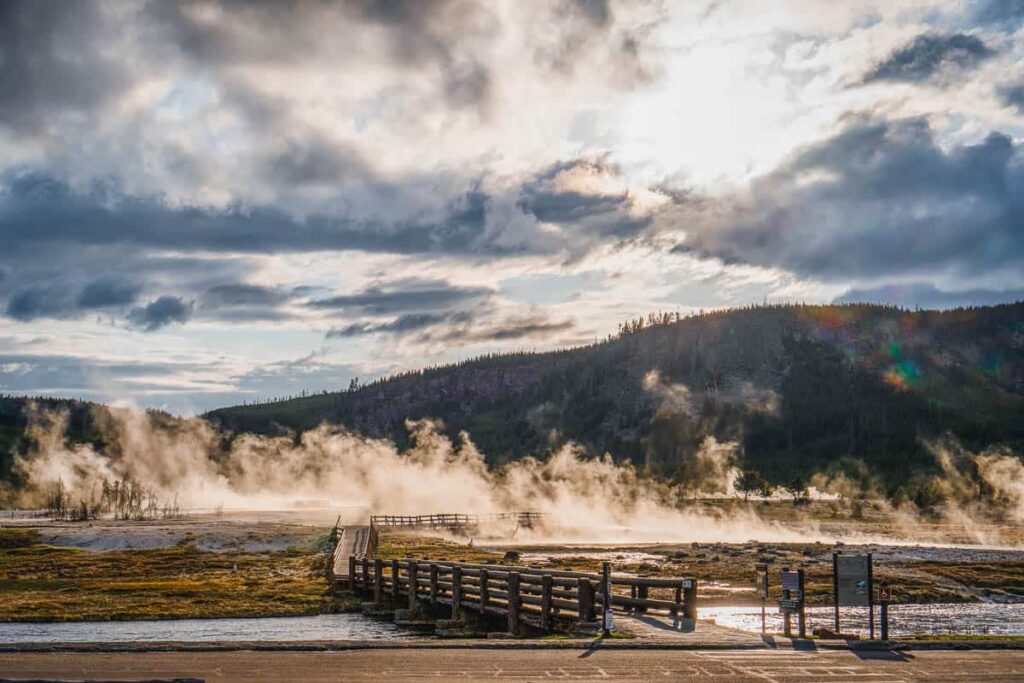
Best Hotels in Yellowstone
Below’s a compiled list of some of the most popular mid-range hotels in the closest towns to Yellowstone National Park’s entrances.
| Hotel | Benefits |
|---|---|
| Cody, WY: The Cody Hotel | – Near the East Entrance – Perfect base for exploring both the park and cowboy country – Continental breakfast with indoor pool and hot tub |
| Gardiner, MT: Yellowstone Gateway Inn | – Spacious suites with full kitchens – Located just one mile from the North Entrance – Great for wildlife viewing |
| Bozeman, MT: The LARK | – Located in downtown Bozeman with plenty of dining and shopping options nearby – About 1.5 hours drive to Yellowstone – Unique, modern renovations |
| West Yellowstone, MT: Explorer Cabins at Yellowstone | – Private cabins with everything you need – Just minutes from the West Entrance – Fire pits and picnic areas available |
| Jackson, WY: Snow King Resort | – Stunning views of the Teton mountains – Close proximity to both Yellowstone and Grand Teton National Parks – On-site restaurants and outdoor pool and jacuzzi |
Campgrounds in Yellowstone
Here’s a handy guide to campgrounds in Yellowstone National Park and the unique benefits they each offer.
| Campground | Unique Features | Nearest Entrance |
|---|---|---|
| Bridge Bay Campground | Great for tents and RVs under 30 ft | East Entrance |
| Canyon Campground | Balance of natural beauty and modern amenities | South Entrance |
| Grant Village Campground | Ideal for staying close to Yellowstone Lake | South Entrance |
| Madison Campground | Known for its extended operating season, it is one of the most popular sites. | West Entrance |
| Indian Creek Campground | Perfect for peace and quiet | North Entrance |
| Lewis Lake Campground | A great choice for anglers, as it’s near the lake | South Entrance |
| Mammoth Campground | Open year-round and located near some of the most famous attractions | North Entrance |
| Slough Creek Campground | Ideal for wildlife watchers | Northeast Entrance |
Places to Visit with More Time
Other Things to Do in Yellowstone
- Yellowstone Lake: The largest high-elevation lake in North America, offering boating, fishing, and stunning panoramic views of the surrounding wilderness.
- Mount Washburn: A challenging hike leading to one of the best 360° views of the park; it’s particularly impressive for wildflower spotting in July.
- Fairy Falls Trail: For a more secluded hike, the trail to Fairy Falls offers a quieter retreat. The falls themselves are some of the tallest in Yellowstone at approximately 200 feet, and the hike includes a view of Grand Prismatic Spring from a distance.
- The Hoodoos: Known as the “fairy chimneys,” this grouping of spire-shaped rock formations is tucked away near the canyon, and it’s a bizarre landscape sculpted from centuries of erosion.
- Firehole Canyon Drive: A one-way road that lets you enjoy the beauty of the Firehole River, with opportunities to spot wildlife and see features like the Firehole Falls without having to hike.
- Petrified Forest: This remote section of the park holds large petrified trees that turned to stone over millions of years. It’s a fascinating off-the-beaten-path hike for those interested in geology and paleontology. Arizona’s Petrified Forest is another famous place to see this.
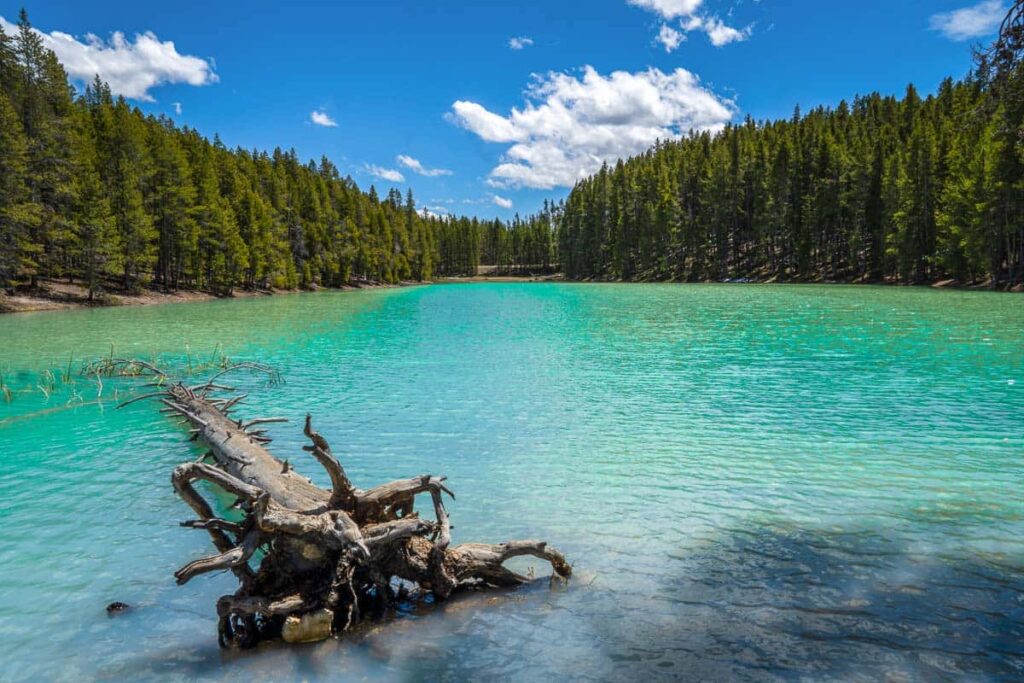
Day Trips from Yellowstone
Here are some exciting day trips from Yellowstone National Park that are within a 3-hour drive. I’m not adding the drive time since it really depends on where you are in the park.
- Grand Teton National Park: With its mountain scenery and abundant hiking trails, it’s like Yellowstone’s younger, slightly smaller sibling.
- Jackson Hole, Wyoming: This charming western town has art galleries and excellent dining options to outdoor activities like skiing, snowboarding, white water rafting, and hiking.
- Cody, Wyoming: Known as the “Rodeo Capital of the World,” Cody is a historic mountain town for a fun-filled day with the Buffalo Bill Center of the West and nightly rodeos in the summer.
- Bozeman, Montana: A college town with a great downtown area full of shops, restaurants, and breweries.
- Quake Lake (Earthquake Lake Visitor Center): Learn about the 1959 earthquake that created this lake and the dramatic landscapes.
- Virginia City, Montana: Experience the preserved Victorian-era buildings in this old mining town.
- Big Sky, Montana: Go skiing in winter or hiking and zip-lining in summer, Big Sky has year-round outdoor activities.
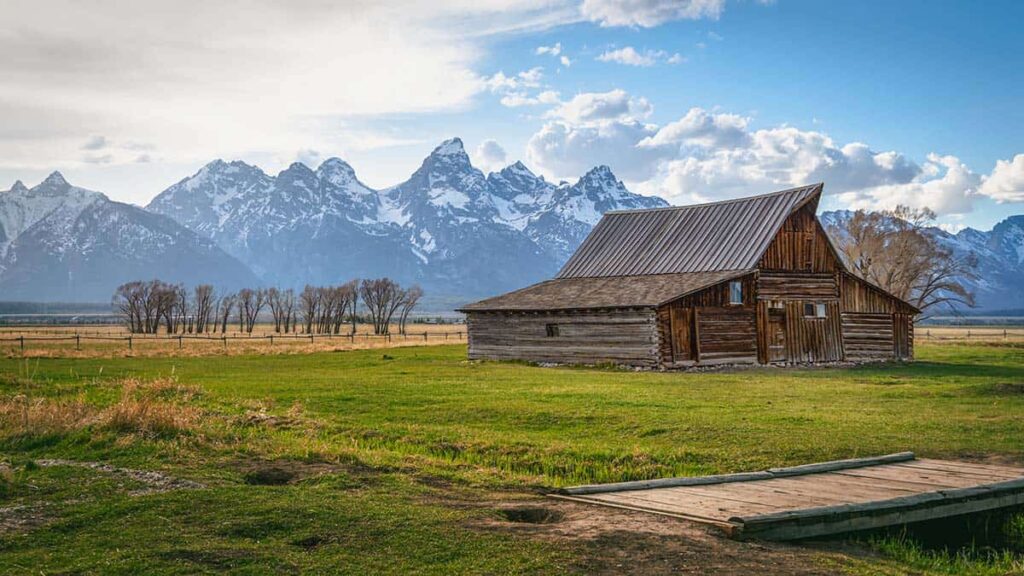
Is 1 Day Enough for Yellowstone
Visiting Yellowstone in just one day is tough. If you’re short on time, prioritize the park’s most famous sights: Old Faithful geyser, the colorful Grand Prismatic Spring, and the dramatic Lower Falls in the Grand Canyon of Yellowstone.
If you have extra days, head into the backcountry on trails to hidden geysers, peaceful meadows, and sweeping views. Rise early for some wildlife spotting in Lamar Valley—home to wolves and bison—or walk the unique landscapes of Mammoth Hot Springs.
Best Time To Visit
The ideal time to go to Yellowstone National Park is the brief, temperate summers from late May to September. It’s the only season the park is fully operational, with colorful meadows and wildflowers in full bloom, sunny skies, and temperatures averaging 70°F (21°C).
Encounters with the park’s mammals, like its renowned bison herds, are frequent. However, it’s also the peak tourist season, meaning popular sites like Old Faithful and the Grand Prismatic Spring can be crowded.
Autumn in Yellowstone has some of the most beautiful fall foliage. The wildlife, particularly the elk, become more active as the rutting season commences. The weather is cooler and can fluctuate, with temperatures ranging from 30°F to 60°F (-1°C to 15°C), and the crowds wane. Just be sure to verify which facilities and roads are open, as services begin to close down after Labor Day in preparation for winter.
Winter is a wholly different experience, as much of the park is in a thick blanket of snow while most roads are closed to regular vehicles. Guided snow coach tours allow visitors to see the geysers, hot springs, and animals in a frosty setting.
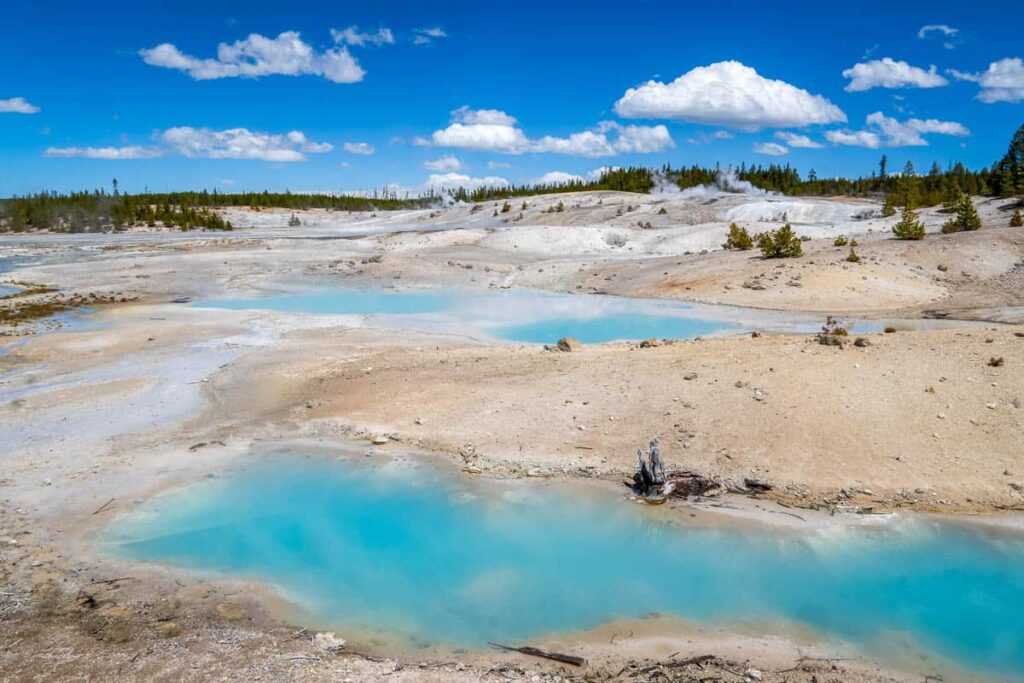
How to Get There
Yellowstone National Park, the first and one of the most extensive national parks in the U.S., is accessible through various routes and methods.
Use DiscoverCars to find rental car deals, or rent and RV or campervan through Outdoorsy.
Nearest Cities and Airports
Yellowstone boasts five entrances, each closer to different cities and airports. Travelers can choose the most convenient city as their travel base:
- North Entrance: Closest to Gardiner, Montana, and the year-round entrance, you can fly into Bozeman Yellowstone International Airport (BZN), which is about a 1.5-hour drive away.
- West Entrance: The town of West Yellowstone, Montana, is the gateway here, served by Yellowstone Airport (WYS), a seasonal facility. Otherwise, Bozeman’s airport is an alternative, providing a scenic 2-hour drive to this entrance.
- South Entrance: This entrance is nearest to Jackson, Wyoming, with Jackson Hole Airport (JAC) being the closest airport located just an hour away, offering views of Grand Teton National Park en route.
- East Entrance: Cody, Wyoming, is the nearest city, and visitors can fly into Yellowstone Regional Airport (COD), which is about a 1-hour drive to this entrance.
- Northeast Entrance: The closest cities are Cooke City and Silver Gate, Montana. The nearest air travel options include flying into Billings Logan International Airport (BIL) in Billings, Montana, and then undertaking a drive that will take approximately 3 hours.
Methods of Travel
- By Air and Car Rental: Most travelers fly to one of the nearby airports and rent a car for flexibility in navigating park roads and the surrounding attractions.
- Bus Tours: Several bus tours operate, providing an organized and stress-free option for those who prefer not to drive. Check out these top options from Jackson, Bozeman, and West Yellowstone.
- Driving: Visitors driving from other U.S regions will find the road trip an adventure in itself, passing through beautiful landscapes. Motorists should be prepared for mountain driving and potential seasonal road closures.
Regardless of how you get there, check for up-to-date information on park roads, especially during winter when some entrances are closed and access is limited to snowcoaches and snowmobiles.
| City | Distance to Closest Entrance | Approximate Driving Time |
|---|---|---|
| Bozeman, MT | 87 miles | About 1.5 hours |
| Cody, WY | 52 miles | Roughly 1 hour |
| Jackson Hole, WY | 57 miles | Around 1.5 hours |
| Idaho Falls, ID | 110 miles | Approximately 2 hours |
| Billings, MT | 132 miles | Give or take 2.5 hours |
| Salt Lake City, UT | 320 miles | Roughly 4.5 hours |
| Denver, CO | 520 miles | About 8 hours |
Final Thoughts: Day Trip to Yellowstone
Visiting Old Faithful’s impressive eruptions, being wowed by the colorful Grand Prismatic Spring, and spotting bison so close to you are just a few highlights of a Yellowstone itinerary. I honestly recommend you stay longer if you can; there’s just too much to see.
And since you’re here, you should definitely make time for at least a day trip to Grand Teton National Park as well.
Before you Close That Tab…Where to Next in the Area?
Grand Teton and Yellowstone are amongst the most impressive places I’ve ever seen. I 100% understand why this is the oldest national park in the world. Here’s more information on this Wyoming area to help plan your journey.
Catherine, a seasoned travel writer, has lived in 4 different states and explored 36 states and 28 national parks. After spending two years embracing van life, she's now dedicated to sharing her vast knowledge of day trips across America. Catherine's other works has been referenced in major publications like MSN, Self, and TripSavvy.
| MY FAVORITE TRAVEL RESOURCES |
✈️ Find amazing guided tours and experiences with Viator to maximize your time! 🏘️ Plan ahead and secure your accommodation with Booking.com in advance. 🧾 Rent a car with Discovercars in advance and get the best prices for your day trip adventures. |

